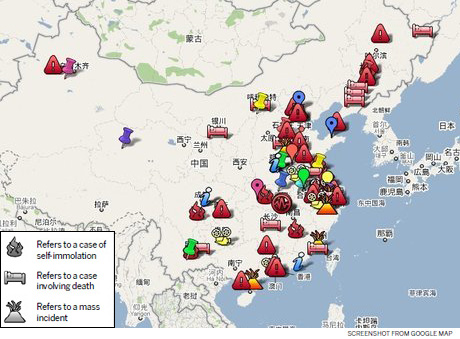Society
Map burns red for forced demolitions
By Wang Huazhong (China Daily)
Updated: 2010-10-27 08:18
 |
Large Medium Small |
BEIJING - Homes are sweet and comfortable, but maybe not those built through forced demolitions.
A "Blood House Map" marking violent demolitions is rapidly gaining popularity on the Internet, reminding the populace of the pain of China's urbanization.

The map, open for public edit on Google Maps, marks 86 reported violent demolitions dating back to 2001. Red icons such as beds, fires and volcanoes are used to tag incidents in which people reportedly died, set themselves ablaze or rose in protest.
As of 10 pm on Tuesday, the map had been viewed more than 226,000 times since it was created on Oct 8. But editing of the map was temporarily closed on Tuesday due to "malicious marking" by some, according to the map drafter.
The map shows red tags concentrated mostly in China's rich eastern and coastal regions. Few, in contrast, are left on the hinterlands in Central and West China.
"Those people who lost their lives during demolition confrontations - be they property residents or members of the demolition squad - somehow fell victim to the country's fast development," the map's creator told China Daily on Tuesday on condition of anonymity.
"The map is their monument."
He said a violent demolition in Baihutou village in South China's Guangxi Zhuang autonomous region on Oct 7 shocked him and fueled him to draft the map.
"One after another, cases of forced demolition tend to be diluted by the sea of information. Therefore, a new way is needed for people to express their emotion on the issue and possibly contain it," the drafter said.
He and the three other co-drafters of the map did not know each other in the cyber world before, but they gathered for a common idea - "to boycott the blood houses".
He then used the name "Blood House Map" behind the screen, and left a descriptive message for the map: "Let us consumers be united and boycott those blood houses!"
The description asked netizens, who are to add new tags to the map to represent incidents, to mention names of new residential projects rising up on the forcibly seized land.
As for the malicious marking, the mapmaker said he will find a trustable website or publication to carry on mapping and open it for public edit as soon as possible.
The map includes incidents that have shocked the nation, such as the demolition notice with a bullet attached to threaten residents in Hohhot city.
It also displays incidents in which former owners set themselves on fire, such as one case in Chengdu of Sichuan province and another in Yihuang county of Jiangxi province, as their last resort to defend their properties.
One netizen, qhsl, wondered if the map could mark all violent demolition cases, as "some cases that had not been made public may vanish in time".
But another netizen, airyxiang, added: "The least I would like to see is the county blanked by the red (tags)."
Lu Huilin, an associate professor of sociology at Peking University, said forced demolition is a challenge to China's urbanization.
"Urbanization in such a way is contrary to social justice and is not sustainable. The government should find the balance between economic development and people's interests," he said.
Cao Yin contributed to this story.




